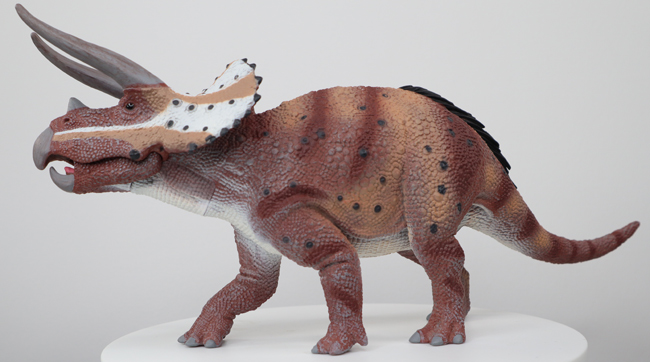The University of Manchester’s Dr Phil Manning in Search of Triceratops
Dr Phil Manning from the University of Manchester’s School of Earth, Atmospheric and Environmental Sciences is setting out to explore the Badlands of South Dakota in a bid to find and excavate the fossilised remains of a Triceratops. Dr Manning is part of a field team in search of Triceratops.
Last year’s prospecting of several promising locations suggested at least three skeletons of this iconic, famous three-horned dinosaur were gently weathering from 66-million-year-old rocks at a secret fossil rich site.
In Search of Triceratops
In his latest trip, Dr Manning is leading a team to evaluate the potential for excavating one of the creatures from its rocky tomb.
The pioneering palaeontologist and his team are famed for their research work on the hadrosaur Dinomummy, known as “Dakota”, helping dinosaurs “virtually” walk, zapping Archaeopteryx lithographica with particle accelerators and tracking the enigmatic Tyrannosaurus rex in the Badlands of Montana.
The starkly-isolated Hell Creek Formation provides the most promising sites for the discovery of Late Cretaceous dinosaur remains in the world.
This is the last slice of geological time that contains the fossil remains of dinosaurs, before their mass extinction. Dr Manning, is confident that one of the Triceratops will be ideal for their research programme.
“We have been working on the exceptional preservation of soft tissue and the biomechanics of dinosaurs from the Hell Creek for over five years now, but this is our first major Manchester-led expedition to this very promising field area.”
A cast of Stan the T. rex already sits in the Manchester Museum, erected by a museum team and Dr Manning five years ago.
The Hell Creek Formation
This fearsome predator from the Hell Creek Formation is also well-known from the area where Dr Manning and his team are working on the Triceratops
He said:
“It’s great that we have a chance to look at one of the prey animals of the mighty T. rex – who knows what we might find associated with the bones of this magnificent creature from the Cretaceous, maybe a predator tooth or three?”
The team, which includes Dr William Sellers from the University of Manchester and a group of co-workers from the University of Pennsylvania and other institutions in Philadelphia, hope to find additional pristine remains of dinosaurs this year in this very remote landscape.
In Search of Triceratops – A Replica of T. horridus

CollectA Triceratops horridus dinosaur model (left lateral view). Picture credit: Everything Dinosaur. Picture credit: Everything Dinosaur.
Picture credit: Everything Dinosaur
The Triceratops model is from the CollectA scale model range, to view this range of dinosaur and prehistoric animal figures: CollectA Deluxe Prehistoric Life Models.
Dr Sellers, who works on dinosaur locomotion at Manchester, commented:
“The bones of Triceratops will make a perfect large quadrupedal dinosaur model to study dinosaur locomotion. We have already published on the maximum running speed of predators and even hadrosaurs, but Triceratops are just wonderful creatures to behold. Many have compared them to rhinoceros, but our work indicates these animals moved quite differently from these modern herbivores.”
The fieldwork is part of an on-going research programme between the University of Manchester and the University of Pennsylvania, Stanford University and the Museum of Prehistoric Life in Price (Utah).
Dr Manning is head of the palaeontology research group at the University of Manchester and a research fellow at the Manchester Museum.
Dr Manning stated:
We have used techniques as diverse as evolutionary robotics, high-performance computing, finite element modelling, LiDAR, high-resolution x-ray tomography, nanoindentation, as well as recently published work using synchrotron light sources. These cutting edge approaches have provided significant advances across the whole subject, generating high-profile international interest.”
We wish Dr Manning and his colleagues the very best and hope to hear more about their fieldwork over the next few weeks or so.






Leave A Comment